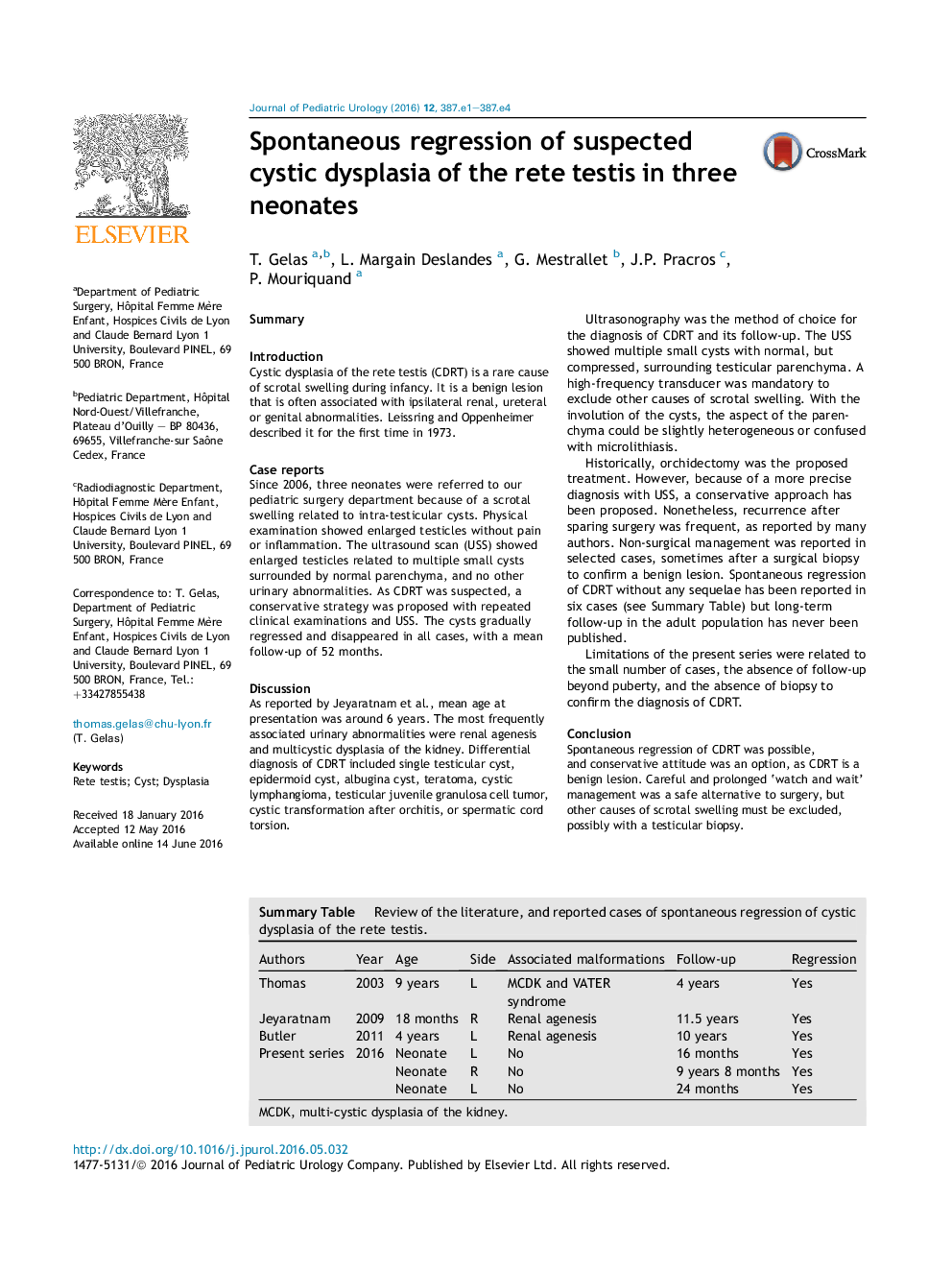| کد مقاله | کد نشریه | سال انتشار | مقاله انگلیسی | نسخه تمام متن |
|---|---|---|---|---|
| 5718712 | 1411256 | 2016 | 4 صفحه PDF | دانلود رایگان |
SummaryIntroductionCystic dysplasia of the rete testis (CDRT) is a rare cause of scrotal swelling during infancy. It is a benign lesion that is often associated with ipsilateral renal, ureteral or genital abnormalities. Leissring and Oppenheimer described it for the first time in 1973.Case reportsSince 2006, three neonates were referred to our pediatric surgery department because of a scrotal swelling related to intra-testicular cysts. Physical examination showed enlarged testicles without pain or inflammation. The ultrasound scan (USS) showed enlarged testicles related to multiple small cysts surrounded by normal parenchyma, and no other urinary abnormalities. As CDRT was suspected, a conservative strategy was proposed with repeated clinical examinations and USS. The cysts gradually regressed and disappeared in all cases, with a mean follow-up of 52 months.DiscussionAs reported by Jeyaratnam et al., mean age at presentation was around 6 years. The most frequently associated urinary abnormalities were renal agenesis and multicystic dysplasia of the kidney. Differential diagnosis of CDRT included single testicular cyst, epidermoid cyst, albugina cyst, teratoma, cystic lymphangioma, testicular juvenile granulosa cell tumor, cystic transformation after orchitis, or spermatic cord torsion.Ultrasonography was the method of choice for the diagnosis of CDRT and its follow-up. The USS showed multiple small cysts with normal, but compressed, surrounding testicular parenchyma. A high-frequency transducer was mandatory to exclude other causes of scrotal swelling. With the involution of the cysts, the aspect of the parenchyma could be slightly heterogeneous or confused with microlithiasis.Historically, orchidectomy was the proposed treatment. However, because of a more precise diagnosis with USS, a conservative approach has been proposed. Nonetheless, recurrence after sparing surgery was frequent, as reported by many authors. Non-surgical management was reported in selected cases, sometimes after a surgical biopsy to confirm a benign lesion. Spontaneous regression of CDRT without any sequelae has been reported in six cases (see Summary Table) but long-term follow-up in the adult population has never been published.Limitations of the present series were related to the small number of cases, the absence of follow-up beyond puberty, and the absence of biopsy to confirm the diagnosis of CDRT.ConclusionSpontaneous regression of CDRT was possible, and conservative attitude was an option, as CDRT is a benign lesion. Careful and prolonged 'watch and wait' management was a safe alternative to surgery, but other causes of scrotal swelling must be excluded, possibly with a testicular biopsy.Summary Table. Review of the literature, and reported cases of spontaneous regression of cystic dysplasia of the rete testis.AuthorsYearAgeSideAssociated malformationsFollow-upRegressionThomas20039 yearsLMCDK and VATER syndrome4 yearsYesJeyaratnam200918 monthsRRenal agenesis11.5 yearsYesButler20114 yearsLRenal agenesis10 yearsYesPresent series2016NeonateLNo16 monthsYesNeonateRNo9 years 8 monthsYesNeonateLNo24 monthsYesMCDK, multi-cystic dysplasia of the kidney.
Journal: Journal of Pediatric Urology - Volume 12, Issue 6, December 2016, Pages 387.e1-387.e4
